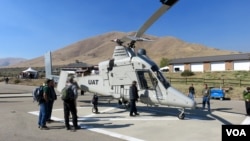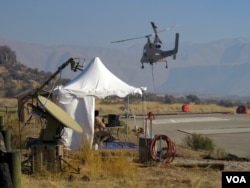Consumer drones look like children's toys compared with the unmanned, water-dropping helicopter that was demonstrated for U.S. government officials this month. The K-MAX chopper is the largest of several remotely piloted firefighting aircraft to get a tryout this year for firefighting duty.
The dual-rotor helicopter looks as if it’s been squished from the sides. It demonstrated water drops and ferried supplies up and down a mountain. All of the missions were flown by remote control from a ground station set up next to the helipad. A pilot sat in the one-seat cockpit ready to take the controls — just in case.
WATCH: Drones Power Up to Fight Wildfires
Helicopter maker Kaman Aerospace produced the K-MAX. Vice President Bob Manaskie said it can fly through thick smoke or darkness, situations that force current firefighting aircraft to stay on the ground. It can lift up to 27-hundred kilos, the equivalent of its own weight.
“We can fight fires 24/7, unmanned or optionally manned. That’s the advantage," he said. "You can get water on the fires 14 or 15 extra hours per day where a manned system can’t.”
Art Hinaman, assistant director for aviation at the U.S. Forest Service, said he saw “a lot of potential” at the initial pitch.
“It’s fascinating that it can be done, that the technology is there," he said. "For us, the ability to do that without having to risk a pilot in low light level conditions, poor visibility and weather [in which] you just can’t fly — and the guys on the ground need the help — that’s pretty monumental.”
Brad Koeckertiz, the unmanned aircraft program manager with the U.S. Department of Interior, figures it will take a few more years to integrate drones into all the other routines found in fighting wildfires, but said he was confident that optionally piloted aircraft would become a tool that firefighters regularly use.
Not just for fires
The U.S. Marine Corps operated two K-MAX helicopters in the unmanned configuration in Afghanistan to resupply remote outposts at night. K-MAX shuttles replaced dangerous convoys on the ground.
“We’ve tweaked it to where it is very safe," Manaskie said. "When we put it in Afghanistan initially, the Marines wouldn’t put people underneath the aircraft as it was hovering because they were afraid, unmanned, it would fall down. By the end, there were tons of people under there hooking up stuff. They got very confident with it.”
The K-MAX helicopter is the third remotely piloted aircraft to get a federal tryout this fire season. The first two tests used smaller, winged aircraft to identify and map hot spots. Boeing subsidiary Insitu showed off a repurposed military reconnaissance drone called the ScanEagle over a forest fire in Olympic National Park. Then Textron Corp. demonstrated its Aerosonde Mark 4.7 surveillance drone over a different forest fire north of McCall, Idaho.
There is an element of good drone/bad drone to this. More than a dozen times this year, unauthorized hobby drones flew too close to active wildfires in the American West, which forced temporary halts to aerial firefighting operations.
That is one of the reasons behind the Federal Aviation Administration's plans to require many drone aircraft to be registered. FAA chief Michael Huerta said registration would increase pressure on drone operators to fly responsibly.







